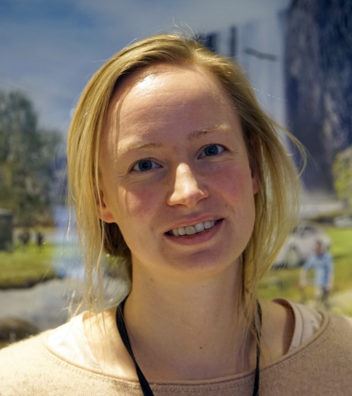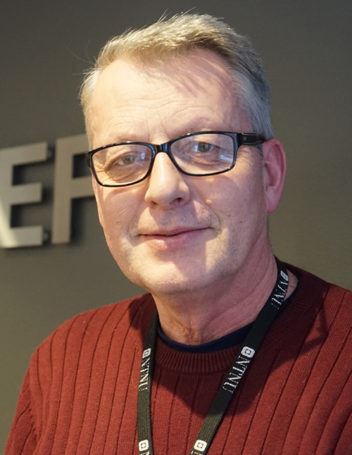The hydropower industry needs to be able to use and store rainwater from the mountains in the right place at the right time. It’s critical to distribute the water stored in reservoirs – the energy storage vessel for the power industry – in the best possible way.
“Precise planning and modelling pay,” says Ellen Krohn Aasgård. She recently earned her PhD developing the SHOP (Short-term Hydro Operation Planning) program at NTNU and is a research leader at SINTEF Energy.
- You might also like: One hundred years of producing energy — from water
SHOP – a planning tool for generating power

“SHOP helps power plants plan their production for periods of one to two weeks. For greatest efficiency, hydropower has to be produced when demand is high. But it’s no easy task to achieve efficient operation and simultaneously pay attention to the environment and aquatic life in the waterways,” says Ellen Krohn Aasgård, who recently completed her PhD on the topic of SHOP. Photo: Mona Sprenger
SHOP is a software program used to distribute water resources so that they are available for power generation where they are needed – and exactly when they are needed. SHOP ensures that plants produce as much power as possible when the need for power peaks. The tool also enables the power industry to produce electricity with as little water as possible.
“SHOP helps power plants plan their energy production for periods of one to two weeks. For greatest efficiency, hydropower has to be produced when demand is high. But it’s no easy task to achieve efficient operation and simultaneously pay attention to the environment and aquatic life in the waterways,” says Aasgård.
SHOP has been adapted to various watercourses and includes detailed descriptions of technical equipment like aggregates, pumps, discharge gates and tunnels.
“The program helps power producers get the most out of their production, but it also supports trade in the energy market. Now we’ve expanded the model so that it can provide support for bidding decisions that take several markets into account,” says Aasgård, who addressed this topic in her thesis.
- You might also like: Land under water — estimating hydropower’s land use impacts
Profitable for Norwegian society
Norwegian power companies are mainly owned by municipalities, counties and the state, so increased income also benefits Norwegian society as a whole.
“Lost future revenues are the most important operating cost in the hydropower industry. The better you utilize the water, the better it is for everyone,” says Hans Ivar Skjelbred.
Skjelbred is a research scientist and the SHOP Manager at SINTEF. He will be submitting his PhD thesis on SHOP this spring.
Billions to gain
Norwegian power production consists of 96 per cent hydropower and is one of the country’s most important natural resources. A recent report from Impello Management and Menon Economics estimates that the use of SHOP increases the value of the water in Norwegian reservoirs by two per cent. That amounts to an estimated gain of NOK 6.8 billion in cash over the past decade. According to the report, the potential present value is NOK 12 billion, assuming all Nordic power producers use the SHOP system.
“We’re proud of what we’ve achieved. SHOP is a sterling example of good collaboration between SINTEF and NTNU – and the values we can create,” says Olav Bjarte Fosso. He is a professor in NTNU’s Department of Electrical Engineering.

“The main challenge has been that no two watercourses are alike. This has demanded tremendous creativity in terms of technical solutions, because there’s always something special to be solved,” says NTNU’s Professor Olav Bjarte Fosso. Photo: Mona Sprenger
Asked what has been the biggest challenge, Fosso said the main challenge is that no two watercourses are alike. This has demanded tremendous creativity in terms of technical solutions, because there’s always something special to be solved. Little improvements are being made all the time.
- You might also like: Norway could be Europe’s green battery
30 years of research
It all started in 1989, when the Statkraft power plants contacted Fosso, who at that time was employed by SINTEF Energy. Statkraft wondered if it was possible to create a tool that could make it simpler for the power industry to make the right short-term decisions.
“As a relatively new employee, it became my job to develop this model. We created a version that we tested in the spring of 1990, but a lot was happening in the industry at the time, and the initial model wasn’t pursued,” Fosso says.
Persistence paying off
Nevertheless, SHOP didn’t end up in the circular file.
“It takes about ten years to get research results operating on the ground. You need persistence to succeed. We’ve managed to keep the activity going ever since the pilot phase – all the way to getting SHOP up and running. If we hadn’t, this project might have been shelved a long time ago,” says the NTNU professor.
First out to use the SHOP program were India and Egypt.
“Since the middle of 2005, the rollout has taken off in the power industry in Norway and Scandinavia,” says Michael Belsnes at SINTEF. He completed his PhD on the SHOP program in 2008 and was responsible for the further development of SHOP until Skjelbred took the baton in 2013.
Rapid technological development
SHOP now has 25 customers who use the system in their daily operations.
Users include most of the hydropower producers in the Nordic countries, and producers in Switzerland, Italy, Austria and Chile. The development of SHOP has been a long run that is still going full tilt. Today, about ten people work at NTNU’s Gløshaugen campus in Trondheim to continue developing SHOP, because work in this field doesn’t let you rest on your laurels.
“Our collaboration with Statkraft and other industrial partners has been crucial for the development work. Another success factor is that the project has ridden a wave of increasing computing capacity and rapid technological development,” says Belsnes.
The building of more international cables and bringing more renewable power into the system are changing the power industry. And technology is simultaneously developing at a furious pace in areas like machine learning and artificial intelligence. SHOP enables the power industry to better manage the growing market uncertainty,” says Skjelbred.
“Nowadays we have computers that can beat humans at chess. Some of those principles can be applied within the hydropower industry, and we can also utilize them to further develop SHOP’s capabilities,” he says.
SHOP has been developed through a large number of projects that have been partly financed by the power industry, The Research Council of Norway, RENERGI and ENERGIX.

